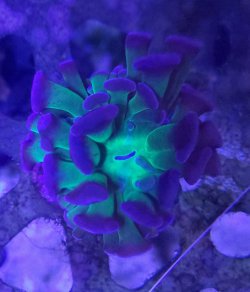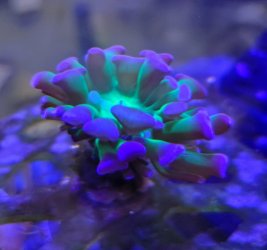Hello all, I've somewhat recently started up a saltwater tank, my first, and it's somewhere between 8-10 months old at this point. About three months ago, I put my first corals in, and that consisted of a duncan, blasto, zoanthid, candycane, GSP, and about a week later, a branching hammer coral, all of them on a frag rack about 6 inches below the surface of the water. Getting med-low flow.
All of them were dipped and I found no evidence of pests etc, and all of them but the hammer are doing well. My duncan, GSP and zoas are all putting out new polyps, and the blasto and candycane are both growing. (Even though one of the blastos was completely picked clean by a peppermint shrimp, it completely regrew both heads from the tiniest scraps of nothing.)
This poor hammer just isn't doing well and I'm not sure why.
It's a 15 gallon tank, current parameters are:
Temp: 80 degrees
Salinity: 0.25
Calcium: 440
PH 8.0
Alk: 10.2
Ammonia: 0
Nitrites: 0
Nitrates: 10 ppm
It gets a 3-5 gallon water change every 1-2 weeks, and I was battling a nitrate problem for a bit that has since settled down within the last month I would say. Current inhabitants are 2 ocellaris clownfish, a fire fish, a couple of different snails, a skunk cleaner shrimp, some blue hermits and the corals. All of these guys look healthy and active.
The Hammer has reduced in size by about a third I'd wager since I put it in. It still opens and closes but a decent amount of the tendrils don't inflate or barely do. Was this caused by my high nitrates or is there something else I should be looking out for? Should I give him time to plump back up before I take any further action since the tank has been otherwise holding steady with the above parameters outside of the nitrates? Here's a couple of pictures to show. You can see the under-inflated polyps but how plump the rest look by comparison. Any suggestions would be helpful, thanks!


All of them were dipped and I found no evidence of pests etc, and all of them but the hammer are doing well. My duncan, GSP and zoas are all putting out new polyps, and the blasto and candycane are both growing. (Even though one of the blastos was completely picked clean by a peppermint shrimp, it completely regrew both heads from the tiniest scraps of nothing.)
This poor hammer just isn't doing well and I'm not sure why.
It's a 15 gallon tank, current parameters are:
Temp: 80 degrees
Salinity: 0.25
Calcium: 440
PH 8.0
Alk: 10.2
Ammonia: 0
Nitrites: 0
Nitrates: 10 ppm
It gets a 3-5 gallon water change every 1-2 weeks, and I was battling a nitrate problem for a bit that has since settled down within the last month I would say. Current inhabitants are 2 ocellaris clownfish, a fire fish, a couple of different snails, a skunk cleaner shrimp, some blue hermits and the corals. All of these guys look healthy and active.
The Hammer has reduced in size by about a third I'd wager since I put it in. It still opens and closes but a decent amount of the tendrils don't inflate or barely do. Was this caused by my high nitrates or is there something else I should be looking out for? Should I give him time to plump back up before I take any further action since the tank has been otherwise holding steady with the above parameters outside of the nitrates? Here's a couple of pictures to show. You can see the under-inflated polyps but how plump the rest look by comparison. Any suggestions would be helpful, thanks!



